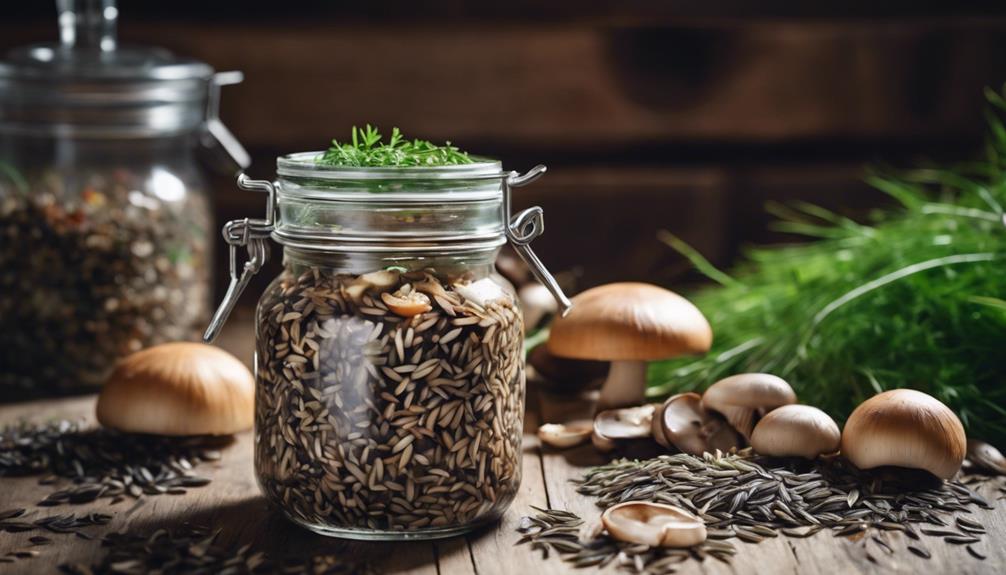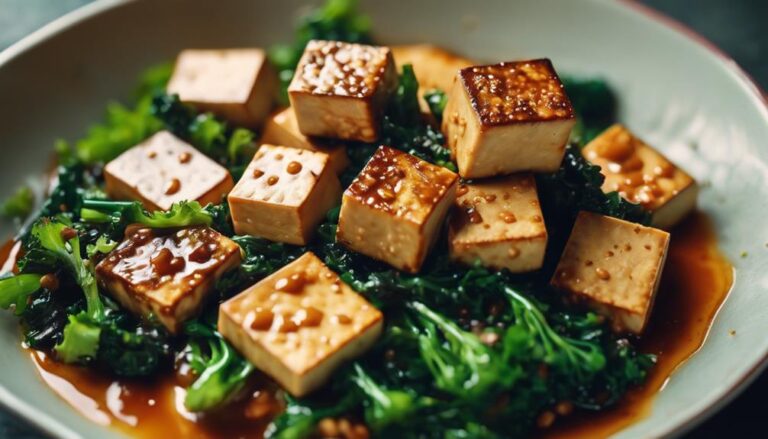Sous Vide Wild Rice and Mushroom Pilaf
Enhance your culinary experience with sous vide wild rice and mushroom pilaf. Immerse yourself in the intricate flavors of hand-harvested wild rice and earthy mushrooms, elevated by precise cooking techniques. Indulge in a dish that unites the rich history of indigenous harvesting practices with the depth of mushroom umami. Explore a symphony of nutty and savory notes expertly crafted through sous vide perfection.
What You Will Learn Here
- Sous Vide method ensures precise cooking temperatures
- Infuses flavors into wild rice and mushrooms
- Enhances nutty and earthy profiles
- Maintains texture integrity
- Provides efficient and consistent results
Origins of Wild Rice

Wild rice, often mistaken for true rice, is actually the seed of an aquatic grass native to North America.
Native American tribes have a rich tradition of hand-harvesting wild rice that spans centuries.
The harvesting and processing methods contribute to the unique flavor and texture of this nutrient-rich ingredient.
Wild Rice History
Indigenous communities across North America have cultivated and cherished the seed of an aquatic grass for centuries, recognizing its significant role as a traditional food staple. Wild rice, despite its name, belongs to an aquatic grass species native to North America. This grain thrives in shallow freshwater lakes and streams, needing warm temperatures to grow successfully.
Harvesting wild rice is a labor-intensive process that involves hand-harvesting mature seed heads from canoes. The rich nutty flavor and chewy texture of wild rice make it a versatile ingredient in various dishes. Its long history of cultivation and importance in Indigenous cultures highlight the deep connection between people and the land, showcasing the reverence for this unique grain.
Native American Tradition
Native American tribes in the Great Lakes region have upheld a rich tradition of hand-harvesting a nutritious aquatic grain, revered for its cultural significance and integral role in ceremonies and gatherings. Wild rice, a staple food in Native American culture, is not actually a type of rice but a grain harvested from aquatic grasses native to North America. The Native Americans traditionally harvest wild rice by hand, using canoes to knock the rice grains into the boat. This process has been passed down through generations as a way to preserve tribal traditions. Wild rice plays an essential role in Native American ceremonies and gatherings, symbolizing unity and prosperity.
| Wild Rice Facts | Description | Importance |
|---|---|---|
| Type | Aquatic grain harvested from native grasses | Cultural significance |
| Harvesting Method | Hand-harvested using canoes to knock grains into boats | Integral role in ceremonies |
| Cultural Significance | Symbolizes unity and prosperity within Native American tribes | Preserved tribal traditions |
Harvesting and Processing
Harvesting and processing the aquatic grass seed known as wild rice involves a traditional method of collection using canoes and sticks to bend the grains into boats for further processing.
The rice, although not a true rice variety, is a staple in North American cuisine. Typically harvested by Native American tribes during late summer to early fall when the grains are mature, the rice is then parched to remove excess moisture for better storage.
Threshing follows, separating the hulls from the edible seeds. This process results in the nutritious and flavorful wild rice used in dishes like pilafs.
Understanding the meticulous steps involved in harvesting and processing wild rice highlights the significance of this ancient practice in honoring nature's bounty.
Wild Rice Varieties

Among the various wild rice varieties available, each type offers unique flavors and characteristics that distinguish them from one another. When considering which wild rice blend to use in your recipes, it's crucial to understand the distinct qualities of each variety:
- Minnesota Wild Rice: This is the most common variety, known for its nutty flavor and chewy texture. It's a versatile option that works well in a wide range of dishes.
- Canadian Wild Rice: Darker and stronger in flavor compared to Minnesota wild rice, this variety adds a robust taste to your dishes, making it ideal for hearty meals.
- Texas Wild Rice: A rare and endangered species found only in the San Marcos River in Texas, this variety offers a unique and limited option for those looking to experience something truly special.
- Other Varieties: In addition to the well-known Minnesota, Canadian, and Texas wild rice, there are other lesser-known varieties that can bring their own distinctive flavors to your culinary creations.
Wild Rice Pilaf Varieties
When exploring wild rice pilaf varieties, you may encounter enticing options like Mushroom and Leek Pilaf, Savory Mushroom Medley Pilaf, or Creamy Mushroom Risotto.
Each variation offers a unique blend of flavors and textures, making them versatile choices for different occasions.
Experimenting with these diverse wild rice pilaf varieties can add depth and richness to your culinary repertoire.
Mushroom and Leek Pilaf
Mushroom and leek pilaf, a delectable combination of earthy mushrooms and sweet leeks, is a hearty and satisfying dish often enriched with nutty wild rice. When preparing this flavorful pilaf, follow these steps for a delightful culinary experience:
- Sauté Mushrooms: In a large saucepan, sauté a variety of sliced mushrooms until they're golden brown and tender.
- Cook Leeks: Add finely chopped leeks to the mushrooms and cook until they're soft and fragrant.
- Incorporate Wild Rice: Mix in cooked wild rice, allowing it to absorb the flavors of the mushrooms and leeks.
- Season with Herbs: Enhance the dish with a sprinkle of fresh herbs like parsley or thyme for a burst of freshness.
Savory Mushroom Medley Pilaf
To elevate your culinary repertoire, explore the rich and flavorful world of Savory Mushroom Medley Pilaf, a delightful twist on the classic Mushroom and Leek Pilaf featuring an array of wild rice varieties and a fragrant mix of savory mushrooms. When preparing this delectable dish, consider the following:
- Variety of Mushrooms: Incorporate button, shiitake, and morel mushrooms for a diverse flavor profile.
- Nutty Wild Rice: Utilize wild rice blend for its nutty undertones and hearty texture.
- Enhancing Ingredients: Include leeks, thyme, parsley, and butter to enhance the depth of flavors.
- Cooking Techniques: Enhance taste by cooking the rice in stock and sautéing the mushrooms to elevate the overall aroma and taste of the pilaf.
Creamy Mushroom Risotto
For a luxurious twist on traditional risotto, consider incorporating wild rice varieties into your Creamy Mushroom Risotto for a delightful blend of nutty flavors and chewy textures.
When preparing this dish, remember the following:
- Variety of Mushrooms: Use a mix of shiitake, cremini, and button mushrooms for a diverse and rich flavor profile.
- Slow Cooking Process: Just like classic risotto, slowly add hot broth to the wild rice, allowing it to absorb the liquid and release starch for a creamy consistency.
- Nutty Flair: The incorporation of wild rice adds a nutty undertone to the dish, enhancing its overall taste.
- Vegetarian Delight: This Creamy Mushroom Risotto is a hearty option for vegetarians, perfect as a side dish or a satisfying main course.
Enhancing the Mushroom Flavor
To enhance the mushroom flavor in your wild rice pilaf, consider sautéing a mix of shiitake, button, and cremini mushrooms in butter or olive oil for a rich, earthy taste.
Deglaze the pan with dry white wine after cooking the mushrooms to bring out their savory notes and add depth to the dish.
Season the mushrooms with salt and pepper while sautéing to guarantee a well-balanced and flavorful addition to your pilaf.
Mushroom Flavor Enhancement Techniques
Enhancing the mushroom flavor in your wild rice and mushroom pilaf can be achieved through various techniques that intensify the earthy and umami notes of the mushrooms.
Start by marinating the mushrooms in a mix of olive oil, garlic, and herbs to enhance their taste. When sautéing, add a splash of soy sauce or Worcestershire sauce for a deeper umami flavor.
Using mushroom types like shiitake, cremini, and oyster adds complexity. Incorporating dried mushrooms or mushroom powder intensifies the earthy notes.
Roasting the mushrooms before adding them to the pilaf caramelizes their sugars, enhancing their richness. In a saucepan, ground black pepper can further elevate the mushroom flavor, creating a delectable dish for your guests.
Complementary Ingredients for Mushrooms
Enhance the earthy flavor of mushrooms in your pilaf by incorporating complementary ingredients like garlic, shallots, and herbs. These additions can elevate the taste profile of your dish, making it a delightful side dish that complements various mains. Consider the following table for a visual representation of ingredients that enhance mushroom flavor:
| Complementary Ingredients | Description | How to Add |
|---|---|---|
| Garlic | Adds a robust flavor to mushrooms | Sautéed with mushrooms |
| Shallots | Imparts a mild oniony sweetness | Sautéed with mushrooms |
| Herbs | Enhances the earthiness of mushrooms | Added during cooking process |
Balancing Mushroom Intensity
Balancing the intensity of mushrooms in your pilaf involves selecting a variety of mushrooms and sautéing them until their umami flavors are rich and pronounced.
To achieve this, melt the butter in a pan over medium heat, then add the mushrooms. Allow them to cook until they release their liquid, intensifying their savory taste.
The addition of dry white wine can further enhance the earthy notes of the mushrooms. Incorporate fresh herbs like thyme or parsley to introduce a hint of freshness and balance the mushroom intensity.
Experimenting with different mushroom combinations, such as shiitake, button, and cremini, will help you discover the perfect harmony of flavors for your wild rice and mushroom pilaf.
Final Thoughts
In considering the Sous Vide wild rice and mushroom pilaf, one is struck by the unparalleled precision and depth of flavor achieved through this innovative cooking method. The controlled temperature guarantees that the rice has absorbed the flavors of the mushrooms entirely, creating a harmonious blend of earthy and nutty notes. Unlike traditional methods that may lead to uneven cooking, the Sous Vide technique ensures consistent results and a perfect texture in every bite.
The convenience of preparing the pilaf in advance, vacuum-sealing it, and cooking it in a water bath at a specific temperature showcases the efficiency and adaptability of Sous Vide cooking. This dish not only highlights the versatility of the technique but also emphasizes the importance of precise cooking to elevate flavors and textures to a new level.
Frequently Asked Questions
Can Wild Rice Be Cooked in a Rice Cooker?
Yes, you can cook wild rice in a rice cooker. It's a convenient method compared to stove-top cooking. Enhance the flavor by using broth instead of water. Explore various wild rice recipes for delightful meals using rice cooker alternatives.
Does Wild Rice Need to Be Soaked Before Cooking?
When it comes to wild rice, you can skip soaking it before cooking. This approach maintains its unique texture and flavor. By forgoing soaking, you retain the nutty taste and nutritional benefits, making it a delicious and wholesome choice.
Can You Overcook Wild Rice?
You can overcook wild rice if you don't monitor the timing closely. Cooking methods like sous vide can help control the process, preserving the perfect texture and flavor. Be mindful of the cooking time to avoid a mushy outcome.
Why Does Wild Rice Take Longer to Cook?
Wild rice takes longer to cook due to its tough outer layer that needs to soften. Its nutritional benefits, including more fiber and nutrients, contribute to the extended cooking time. Various cooking techniques, like sous vide, help retain its unique qualities.
Conclusion
Indulge in the rich and earthy flavors of sous vide wild rice and mushroom pilaf, a dish that perfectly balances nutty wild rice with savory mushrooms.
By employing the sous vide method, you can guarantee that every grain of rice is cooked to perfection and imbued with the delicious flavors of the mushrooms.
Elevate your culinary experience with this delectable and sophisticated dish that will leave your taste buds craving more.











